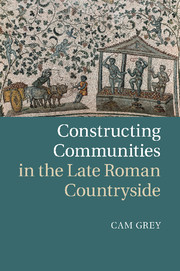Book contents
- Frontmatter
- Contents
- Preface
- List of abbreviations
- Map The late Roman world (sites and regions discussed in the text)
- Introduction
- Chapter 1 Constituting communities
- Chapter 2 What really matters
- Chapter 3 Small politics
- Chapter 4 Power as a competitive exercise
- Chapter 5 Resistance, negotiation, and indifference
- Chapter 6 Creating communities
- Chapter 7 Unintended consequences
- Conclusions
- Bibliography
- Index
Introduction
Studying rural communities in the late Roman world
Published online by Cambridge University Press: 07 September 2011
- Frontmatter
- Contents
- Preface
- List of abbreviations
- Map The late Roman world (sites and regions discussed in the text)
- Introduction
- Chapter 1 Constituting communities
- Chapter 2 What really matters
- Chapter 3 Small politics
- Chapter 4 Power as a competitive exercise
- Chapter 5 Resistance, negotiation, and indifference
- Chapter 6 Creating communities
- Chapter 7 Unintended consequences
- Conclusions
- Bibliography
- Index
Summary
What did rural communities look like in the late Roman world? How did they work? What socio-economic mechanisms were available to peasants of the period for managing subsistence and social risk? The questions are disarmingly simple. But the project of answering them is dogged by the same evidentiary and methodological problems that have long trammeled attempts to answer similar questions for earlier periods. The late Roman world boasts a greater body of written sources relevant to the subject than in earlier centuries, but detailed accounts of the day-to-day workings of rural communities – such as have underpinned comparable studies in medieval, early modern and contemporary contexts – are still almost entirely absent. In the main, the sources that we do possess reflect aristocratic concerns and perspectives more than those of peasants. That is, they focus principally upon problems of organization and control of labor, transmission of rents and taxes, and the nature and form of power and dependence, rather than upon the maintenance of a subsistence livelihood or the negotiation of the “small politics” of rural communities. When the inhabitants of rural communities do appear in these writings, they are characteristically treated as an undifferentiated mass, their social, economic, and political motivations misunderstood, their networks of mutual support and reciprocity beyond occasional mentions of interactions with our aristocratic authors largely opaque.
In this book, I seek to recapture these networks of mutual support and reciprocity, using the written sources in conjunction with archaeological material and theoretical models drawn from comparative contexts and disciplines. I engage in particular with debates in those disciplines concerning the internal workings of rural communities, the nature of relations between the members of those communities and outsiders, and the impact of externally generated changes upon those structures of interaction. I suggest that, in spite of the limitations of our evidence, the countrysides of late antiquity provide an ideal context for contributing to these debates. In championing the late Roman world as a particularly fruitful field for exploring questions current in agrarian studies more broadly, I emphasize the opportunities provided by two factors. On the one hand, the rural landscapes of the late Roman world were almost infinitely diverse in terms of physical topography, economic structures, and social systems. On the other hand, peasant communities exhibit certain behaviors that are broadly congruent and comparable across time and space. Consequently, we must construct a schema for studying the interplay of the generalized and the unique within and between those communities.
- Type
- Chapter
- Information
- Publisher: Cambridge University PressPrint publication year: 2011
- 1
- Cited by

